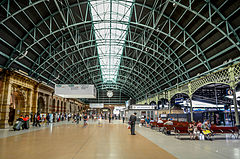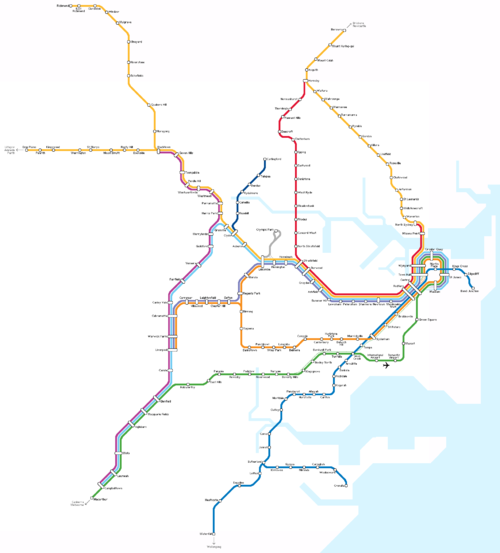Sydney Trains

Sydney Trains is the name of a railway company that operates an extensive network of S-Bahn lines, regional lines and intercity lines in and around the Australian city of Sydney . The trains ran under the name CityRail before 2013. Trains that travel far beyond urban space are called NSW TrainLink .
It was founded in 1990 on the basis of the Transport Administration Act (NSW) 1988 (New South Wales Transport Administration Act 1988). Sydney Trains is owned by the State of New South Wales and a subsidiary of the State Rail Corporation New South Wales (Railcorp); the sister company Countrylink is responsible for long-distance rail transport in rural areas.
Around 900,000 passengers are transported daily on the route network with 302 stations and a track length of 2060 kilometers. Most of the route network is electrified with 1500 volts DC (with overhead lines ), but diesel trains are also used on some remote sections . All trains on the Sydney suburban network are double-decker railcars .
overview
CityRail's route network is a mixture of three different modes of operation, a subway- like network of tunnels in the city center, an S-Bahn in the greater Sydney area and railway lines in rural areas.
The hub of the network is Sydney Central Railway Station . This consists of a terminal station and a through station . The S-Bahn lines pass the through station and travel all or part of the City Circle , a largely underground tunnel ring around the city center. The bundling of several lines results in a train headway time of a few minutes, so that this power supply unit is more like a subway.
The regional lines, known as "Intercity", as well as long-distance trains from the states of New South Wales, Queensland and Victoria as well as the rest of Australia end at the terminus. The regional lines lead to places that are up to 160 kilometers from the city center; the network extends to Newcastle in the north, Lithgow in the west, Goulburn in the southwest and Wollongong , Kiama and Port Kembla in the south. A few regional trains also use the City Circle during rush hour.
Two diesel-powered lines run from Newcastle through the Hunter River Valley to Scone and Dungog , with most trains already turning in Maitland or Telarah. A branch of the South Coast Line between Kiama and Boomaderry- Nowra is also operated by diesel trains .
For the intercity traffic in Sydney, on the one hand, a separate fleet of railcars is used , with the label "Intercity" on the trains. On the other hand, specially adapted S-Bahn trains are used for these services.
Line network
Suburban lines
| line | route |
|---|---|
| Eastern Suburbs and Illawarra Line | Bondi Junction - Central - Sydenham - Wolli Creek - Sutherland - Cronulla / - Waterfall |
| Bankstown Line | City Circle - Central - Sydenham - Birrong - Lidcombe / - Liverpool |
| Inner West Line | City Circle - Central - Strathfield - Lidcombe - Liverpool |
| Airport and East Hills Line | City Circle - Central - Sydney Airport - Wolli Creek - Glenfield - Macarthur |
| South Line | City Circle - Central - Strathfield - Lidcombe - Guildford - Liverpool - Campbelltown |
| Cumberland Line | Bankstown - Guildford - Liverpool - Campbelltown |
| North Shore Line | Berowra - Hornsby - North Sydney - Central |
| Northern Line | North Sydney - Central - Strathfield - Epping - Hornsby |
| Western Line | Central - Strathfield - Lidcombe - Clyde - Bankstown - Emu Plains / - Richmond |
| Carlingford Line | Clyde - Carlingford |
| Olympic Park Sprint | Lidcombe - Olympic Park |
Regional and intercity lines
| line | route |
|---|---|
| South Coast Line | Central * - Waterfall - Wollongong - Bomaderry (Nowra) / - Port Kembla |
| Southern Highlands Line | Campbelltown * - Bowral - Goulburn |
| Blue Mountains Line | Central * - Strathfield - Emu Plains - Lithgow |
| Northern Line | Central - Strathfield - Epping - Berowra - Fassifern - Newcastle |
| Hunter Lines | Newcastle - Maitland - Dungog / - Scone |
* During rush hour, some South Coast Line trains operate on the Central - Bondi Junction section, some on the Southern Highlands Line on the Campbelltown - Central section, and some of the Blue Mountains Line on the North Sydney - Central section.
Connecting bus lines
Sydney Trains also operates some intercity bus routes on certain routes where rail passenger traffic has ceased or the rail line has been closed entirely. These bus routes appear in the timetables and use the same tariff system but are operated by private bus companies on behalf of Sydney Trains. These are the lines:
- Bowral - Thirlmere - Picton
- Wollongong - Robertson - Moss Vale
- Lithgow - Mt Lambie - Bathurst
- Fassifern - Toronto
NightRide bus routes
Night buses have been operating in the greater Sydney area since 1989 . The NightRide buses, operated by private providers on behalf of Sydney Trains, run every hour between midnight and five in the morning (on weekends even every half hour on some routes). Each line is marked with an N and a two-digit number. All Train tickets (with the exception of a single ticket) have unlimited validity. All bus routes, with the exception of the N20, run from George Street in the city center, outside of Town Hall Station.
history
Sydney Trains 'origins date back to 1855 when New South Wales' first railway line opened between Sydney and Parramatta . Parramatta is now a suburb of Sydney, but was then an important center of agriculture. From the beginning, the railroad lines were owned by the state. The state railway network expanded rapidly; Numerous radial lines emerged from Sydney and Newcastle , with suburban traffic on the urban sections and sporadic operation on the rural sections.
All trains were pulled by steam locomotives until the introduction of gasoline- powered locomotives in the 1920s on some low-passenger branch lines. The first electrified route in 1926 was the one between Central and the suburb of Oatley, around 20 kilometers southwest of the city center. In the same year the first underground section between Central and St James was opened. Further electrifications soon followed. An important milestone was the commissioning of the tracks on the Sydney Harbor Bridge in 1932 and the connection of the bridge with the main train station by means of another tunnel.
By 1948 the electrification of the suburban network was largely complete. However, the completion of the City Circle was a long time coming in 1956. In 1979 the partially underground route from the city center to Bondi Junction was completed. Shortly before the start of the 2000 Summer Olympics , new routes to Kingsford Smith International Airport and Sydney Olympic Park were opened.
Between 2002 and 2008, a new, 13-kilometer, largely underground line was built between Chatswood and Epping stations. Among other things, it opens up the grounds of Macquarie University and has been open since 2008.
future
The Chatswood – Epping line merged into a subway. This is a project for a new route from a development area northwest of Sydney (Cudgegong Road) to Epping. Fully automatic single-decker trains have been running there every 4 minutes since 2019. From Epping the trains use the existing route to Chatswood. An extension towards downtown Sydney and further over the Bankstown route is planned for a later date. Until this extension is completed, the classic trains must be switched to Chatswood.
Web links
Individual evidence
- ^ North West Rail Link website: nwrail.transport.nsw.gov.au


